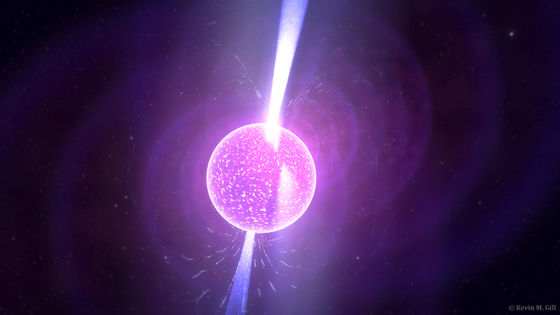Research results show that a cloud of axions, the true identity of dark matter, covers neutron stars, raising hopes for dark matter observations

by
Ordinary matter, which makes up humans, the Earth, and the stars in the night sky, accounts for less than 5% of the matter and energy in the universe; the rest is made up of dark matter and dark energy, the nature of which is still unknown. It is believed that a cloud of hypothetical particles called axions , which are believed to be the true identity of dark matter that makes up a quarter of the universe, is generated around extreme celestial objects called neutron stars, and its density is One hypothesis has been put forward that if it is high enough, it may be possible to capture it using existing observational techniques.
Phys. Rev. X 14, 041015 (2024) - Axion Clouds around Neutron Stars
https://journals.aps.org/prx/abstract/10.1103/PhysRevX.14.041015
Dark matter might live in a dense haze around stellar corpses | Space
https://www.space.com/neutron-stars-axions-dark-matter
Axion clouds around neutron stars could reveal dark matter origins – Physics World
https://physicsworld.com/a/axion-clouds-around-neutron-stars-could-reveal-dark-matter-origins/
In a paper published in Physical Review X on October 17, 2024, a research team led by Dion Noordhuys of the University of Amsterdam's Gravitational and Astroparticle Physics Laboratory (GRAPPA) reported that a particle called an axion could be a supernova that could cause the explosion of a neutron star. They announced that there is a possibility that clouds may form around it, and if so, they could be observed with radio telescopes.

By
The axion was invented as a hypothetical particle to solve the problem of ' CP violation ' in elementary particle physics. Although it has not yet been observed or its existence proven, it is believed to exist in other materials and It has similar properties to dark matter in that it barely interacts with light, meaning it is invisible or tangible.
For this reason, axions are considered one of the leading candidates for dark matter, and the results of this research are attracting attention as they may shed light on the true nature of dark matter.
In addition, a little surprising from a science fiction perspective, the name Axion was borrowed from the dishwashing detergent brand 'Axion' by daily necessities manufacturer Colgate-Palmolive (CP). The particle, which completely solves the problem of 'CP violation' in mechanics, was named 'CP detergent.'

by
The neutron stars that the research team focused on are formed when a star with a mass at least eight times that of the Sun runs out of fuel for nuclear fusion and explodes in a supernova. If this happens, it will collapse into a black hole, but if not, it will become a dense enough object that protons and electrons will combine to produce neutrons.
This is a neutron star, and its density is said to be such that 'the mass of a teaspoon of a neutron star is equivalent to the weight of 85,000 blue whales.'
Neutron stars are sometimes called 'magnetars' because of their extremely strong magnetic fields, and it is possible that axions can be generated at the poles of a neutron star from the electromagnetic fields generated by its magnetosphere.
The axions thus produced can be captured by the neutron star's strong gravity and form a cloud, which can potentially become a dense 'axion cloud' that exceeds the local dark matter density by more than 20 orders of magnitude. , the research team found out.

'Neutron stars, with their enormous gravitational fields, are ideal objects to capture some of the axions that are produced,' said Noordhuis. 'Black holes are also very efficient at capturing axions, but at the same time, they are more efficient at releasing them.' 'And so far, it's completely unclear whether axions are even produced around black holes.'
Axions are very light and barely interact with light, but once enough axion clouds form, a large number of axions can be converted into light through a process called 'axion-photon mixing.' It may also be possible to observe the signal in the form of radio waves.
Research into axion clouds surrounding neutron stars has only just begun, and even if axions are detected, it may not necessarily mean that dark matter has been discovered, nor does it necessarily mean that axions are the only component of dark matter.
'Fully understanding axion clouds will require complementary efforts from multiple disciplines of physics, including particle astrophysics, plasma physics and observational radio astronomy,' said Noordhuis. 'We believe this will spark interdisciplinary efforts that will lead to such future research.'
Related Posts:
in Science, Posted by log1l_ks







